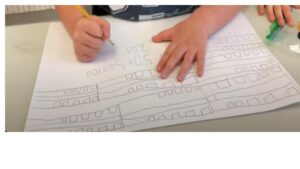Dr. Siddhi Desai, a friend of ours, shared about the cultural background and traditions of Diwali and how she celebrates Diwali by creating these beautiful Rangolis. Read why it is important to her!
Diwali (Dih-wah-lee) is a five-day long festival celebrated by more than 1 billion Hindus, Sikhs, and Jains around the world. It is celebrated according to the Luni-Solar month of Kartika which typically falls between mid-October and mid-November. While the history of Diwali can be traced back to ancient India with various legends, its origin all connect to the triumph of good over evil. This triumph of good over evil or light over darkness is also why lighting diyas, small oil lamps, are an important Diwali tradition.
Across India and other parts of Southern Asia, the specific practices that signify this festival vary based on different legends and traditions from the Vedic era. This Festival of Lights is commonly celebrated by decorating homes with candles and lamps, observing religious rituals, making and eating sweets and snacks, spending time with family and friends, and bursting firecrackers. In Gujarat, a state in Western India, where my family is from, the five days of Diwali are celebrated as Dhanteras, Kali Chaudas, Diwali, Bestu Varas (New Year), and Bhai Beej. The traditions for each of these five days and their significance are rooted in historical, cultural, and environmental factors that impact the specific region. For example, in Ancient India, the state of Gujarat was known to have a large business, as well as a large farming community. In traditional Hindu businesses, Diwali, an auspicious and pious holiday, is considered to be the last day of the financial year. Therefore, the day after Diwali, the first day of the new business year, as well as the beginning of the harvest season, became the Gujarati New Year as it corresponded to the traditions and livelihood of the people and the community. In other parts of India, New Year’s day falls on different days of the year according to various traditions of the region.
One of my favorite Diwali traditions is creating Rangoli designs to decorate the house. These hand drawn patterns are typically created on the floor right outside the front door, and signifies the welcoming of good luck, prosperity, and positive energy. Traditional designs incorporate references to nature and culture, and are often very geometric. The colors in the traditional art form are extracted from natural dyes, like barks of trees, flowers, leaves, etc, however, in more recent times, this powder is created from materials such as powdered limestone, red bricks, dry rice flour, colored sand, quartz powder, flower petals, and colored rocks. Included below are two examples of Rangoli designs I have created in recent years. To learn more about creating and “making Rangolis” Check out Dr. Desai’s blog-https://ssdesai.wordpress.com/2020/06/28/rangoli-designs-connecting-art-culture-and-mathematics/
Problem PosingThis math happening was inspired by creating lanterns to celebrate the Festival of Lights.
|
||||||
Making Assumptions and Considering the VariablesSample Prompt: Gathering Information
|
||||||
Solving- Doing the Mathematics/Building a modelSample Prompt:
Arrangement of lanterns down a hallway |
||||||
Sample Prompt:
Is there a model/formula that I can reuse or share with others?
|
||||||
Analyzing and revising the modelSample Prompt:
[Students noted that if they knew how many lanterns in a hall way length of 10 feet, that they could repeatedly add to reach the length of the hall way. In our case it was a 70 feet long hallway so for 10 lanterns it was 70 lanterns and for 20 lanterns per 10 feet, it ended up being 140 lanterns} {With 100 feet long hallway it would be 10 times the number of lantern on their 10 foot pattern.} |
||||||
Reporting out- Sharing & Connecting Real world Math to school mathSample Prompt:
|







